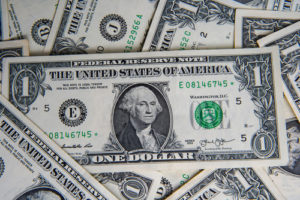
Goodness me. That was quite a week. It is usually wrong to over-analyse the minutiae when markets are in this mood, but this time it is possible both to make sense of the events of the past week and to understand why almost all of the commentary around them is wrong. The starting point is that despite what you will inevitably have seen and heard about tax cuts, sterling and a crisis, this is actually all about the US dollar.
If we ignore the freakish levels of the pound seen overnight and this morning as being caused by the typically illiquid and volatile Asian currency markets, the sterling dollar exchange rate is more or less where it was in 1985. The dollar is at its highest versus the euro and the Japanese yen since 2003 and 1998 respectively. The dollar’s trade-weighted value is at its highest since 2002. Whilst it is understandable that the British press should put a British spin on things, markets are being driven by what is going on in Washington, not Westminster.
Last week the US Federal Reserve raised its interest rates by 0.75%. The precise rate is complex, but let us assume it is at the top end of its targeted range, namely 3.25%. That is, to use a double negative, not an unattractive rate. Especially if one believes (admittedly a significant act of faith) its rhetoric that it will raise this rate significantly further. It is also a truism that when markets are short of confidence, capital flows to where investors think is the safest place to be. 99 times out of 100, that is America and the US dollar. It is a virtuous circle.
Said circle is especially self-fulfilling if we then add in that Japanese interest rates are zero, with the Bank of Japan apparently happy to let the yen weaken. If we assume for simplicity that one can borrow yen interest free, then investing in US dollar gives a theoretically return of 3.25% plus whatever bonus is delivered by the exchange rate. Easy squeezy. We then factor in the ECB, which is speaking tough but almost certainly failing to back that up, plus a UK with a rapidly growing budget challenge. Not only does the world love the dollar, it also hates almost everything else (bar the Swiss franc).
We need to come back to last Friday’s so-called mini-Budget. This primarily cancelled most of the tax rises scheduled by Chancellor Sunak, with a couple of extras thrown in for good measure. The issue is not one of inflation – which we shall come back to – but of footing the bill. First, as we argued a few weeks ago, the UK’s magic money tree has disappeared. Time was, back in lockdown days, that government debt (gilts) was effectively free. The interest rate was as close to zero as made no difference, and the Bank of England promised to buy everything that was printed. Easy squeezy, again.
Now, however, gilt yields are around 4%. The Bank of England, which is front and centre of the current mess, will soon be selling the gilts that it bought to finance lockdown. Not only this, but the gilt market is very biased towards shorter-dated issues, meaning that there is a huge refinancing to be done over the next three years. Between now and the end of 2026, the UK has to deal with the redemption of £377bn worth of gilts. That is the nub of the challenge – who is going to buy the gilts that will finance the energy price cap and whatever the ‘tax cuts’ actually cost?
Before we move on from sterling, we ought to mention the concept of ‘purchasing power parity’, or PPP. This is a very simple gauge for assessing values in currencies by comparing how much it costs to buy a burger. The theory goes that the cost of a meat, or maybe soon vegetable-based, patty should be the same everywhere. PPP is the theoretical exchange rate that equalises the burger. PPP comes with the caveat that in terms of predicting short-term currency moves, it is as reliable as an octopus picking World Cup winners – it is random and terrible. However, on a PPP basis the sterling-dollar exchange, according to the OECD, should be around $1.40. That does not mean that we are not going to parity, or below, but it is a fair indicator that on any reasonable time frame, the selling of the pound has been overdone, probably by quite a long way.
We need to touch on inflation and the Bank of England. Last week the Bank raised UK bank rate by half of one percent to 2.25%. It also said that all of us, plus Presidents Putin and Xi have all been very naughty and we need to be punished by having a recession, which will drive out the inflation that we have caused, and which has nothing whatsoever to do with the Bank. And we should go home, wear sackcloth and ashes, eat gruel and keep the lights off.
Anyway, whether inflation was caused by the Bank (which it was, mostly) or by the price of petrol (which it mostly isn’t), the headline rate is still 10%, give or take. It is also, as if by magic, accepted wisdom that tax cuts are inflationary and thus any fool can see that cutting taxes with 10% inflation is a stupid thing to do. It is an easy narrative. It just lacks any basis in fact. Taxes neither create nor destroy money, they merely determine the amount of capital that is transferred from the private to the public sector. Economists fight like cat and dog about whether fiscal policy affects inflation. They have since we slithered from the primordial soup, and will until the sun goes cold. There is no simple answer.
Our fear is that too many will believe in the myth. There is already clamour for the Bank to introduce emergency rate increases to counter the reckless spending. Despite this being dangerous nonsense, it is quite possible that Andrew Bailey, the current Governor and primary denier of inflationary-responsibility, will see this as his route back to credibility with the City. And lest we are accused of being apologists for the government, we should add that, in our view, some of the chancellor’s measures were decidedly rum. Others, as we argued last week, may be very much for the better.
And then we come onto oil and energy. Brent crude this morning has been trading below $85/bbl. This is back to where we were last November – three months before the invasion of Ukraine. Gas prices have fallen by around 25% in the US over the past month. It will take something extraordinary for inflation not to be falling sharply as we move through 2023. If we combine this with the already evident slowdown in economic activity and Central Banks currently determined to push the western world into recession, then we have a scenario for next year in which the Banks will have to volte face again.
We are not ignoring Ukraine. This is moving into another dangerous phase. The Ukrainian advances complicate the referendums. Once the results are published, then much of what is currently eastern Ukraine will become Russian sovereign territory. Which means that NATO-supported Ukrainian military action in those areas becomes very much more serious. Despite the very welcome fall in oil and gas prices, this is far from over.
It is still time to hang onto one’s topper, and markets are most unlikely to calm down anytime soon. However, the tizz will fade and we can see what we believe to be potentially tremendous value in both equity and bond markets. In the absence of something going very wrong in Eastern Europe, 2023’s prospects are surprisingly brightening, but we should all expect that our patience will be tested further in the coming weeks.
Finally, congratulations to those who sang along to Rhinestone Cowboy last week. Today, back to 1985: “Now look at them yo-yos, that’s the way you do it.” Which self-deprecating classic?
Jim Wood-Smith – Market Commentator and Head of Climate Transition

FPC559
All charts and data sourced from FactSet
Hawksmoor Investment Management Limited is authorised and regulated by the Financial Conduct Authority (www.fca.org.uk) with its registered office at 2nd Floor Stratus House, Emperor Way, Exeter Business Park, Exeter, Devon EX1 3QS. This document does not constitute an offer or invitation to any person in respect of the securities or funds described, nor should its content be interpreted as investment or tax advice for which you should consult your independent financial adviser and or accountant. The information and opinions it contains have been compiled or arrived at from sources believed to be reliable at the time and are given in good faith, but no representation is made as to their accuracy, completeness or correctness. The editorial content is the personal opinion of Jim Wood-Smith, Market Commentator and Head of Climate Transition. Other opinions expressed in this document, whether in general or both on the performance of individual securities and in a wider economic context, represent the views of Hawksmoor at the time of preparation and may be subject to change. Past performance is not a guide to future performance. The value of an investment and any income from it can fall as well as rise as a result of market and currency fluctuations. You may not get back the amount you originally invested. Currency exchange rates may affect the value of investments.
